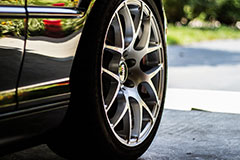What Is the Recommended Pressure for Tires? - Vol.373
One of the aspects of car maintenance is taking care of tires. After all, they are what keep you separated from the ground, and having a quality set of tires optimized for all weather conditions is crucial. So, it only makes sense that you should pay special attention to them. Tires should always be inflated properly to ensure a smooth ride and many carefree years of driving.

What exactly "properly inflated" means? Well, it means that each tire should be pumped to a specified pressure - not too much, but not too little. The exact number is written in the owner's manual of your vehicle, and you'll recognize it by the use of the unit called PSI, or Pounds per Inch. The recommended pressure for most vehicles is 30 to 35 PSI. When keeping your tires to the recommended pressure, you ensure that they will last a long time and that your car will always handle in the best possible way.
The recommended pressure is actually the minimum amount of air pressure required so that your car's maximum load-carrying capacity could be supported. If that pressure gets lower, the fuel economy of your car will get worse - i.e. you'll use more fuel. Another concern with a lower pressure is the car's handling. And what's more, with lower pressure, the tires are going to be worn out sooner, as they are going to flex more easily, especially if you're driving on rough surfaces.
On the other side of the spectrum, we have the maximum tire pressure. This information can be found somewhere on the sidewall of the tire, and it stands for the maximum cold pressure that's required so that the tire can carry its maximum load. The word "cold" simply indicates the pressure of tires when they are cold. That means right in the morning, before they have been used, or if they are sitting in a cold place, protected from the heat of the sun. If the tires are pumped to the maximum pressure, the handling of the entire car will change. Cornering might actually improve, and some racers take advantage of that, but for everyday driving, this is absolutely not recommended, as inexperienced drivers can quickly find themselves in a bad situation.
Another danger of overinflated tires is the wear and tear. Namely, if the tire pressure is too high, the central part of the tire will wear out more quickly, as it's exposed to the road the most compared to other parts of the tire, so the distribution is unequal.
You might not know this, but tires lose pressure every single day. Weather can greatly impact the pressure - for example, during winter months, tires will lose one or two pounds of air per month. On the other hand, during summer months, and in warmer climates in general, that number can be even higher. Because of that, you need to check the tire pressure from time to time. This can be done at any gas station, but you don't have to do it every time you stop to fill up gas. Every other time might do fine, but generally, try to keep up with the tire pressure and stick to the manufacturer's recommend PSI.
The car itself can also tell you if there are any problems with your tires' pressure. If you own a car equipped with a tire-pressure monitoring system (TPMS), a special notification on the dashboard will let you know if there are any problems. Namely, you will get a notification that a tire is at least 25% underinflated, so you can take immediate action and solve the problem.